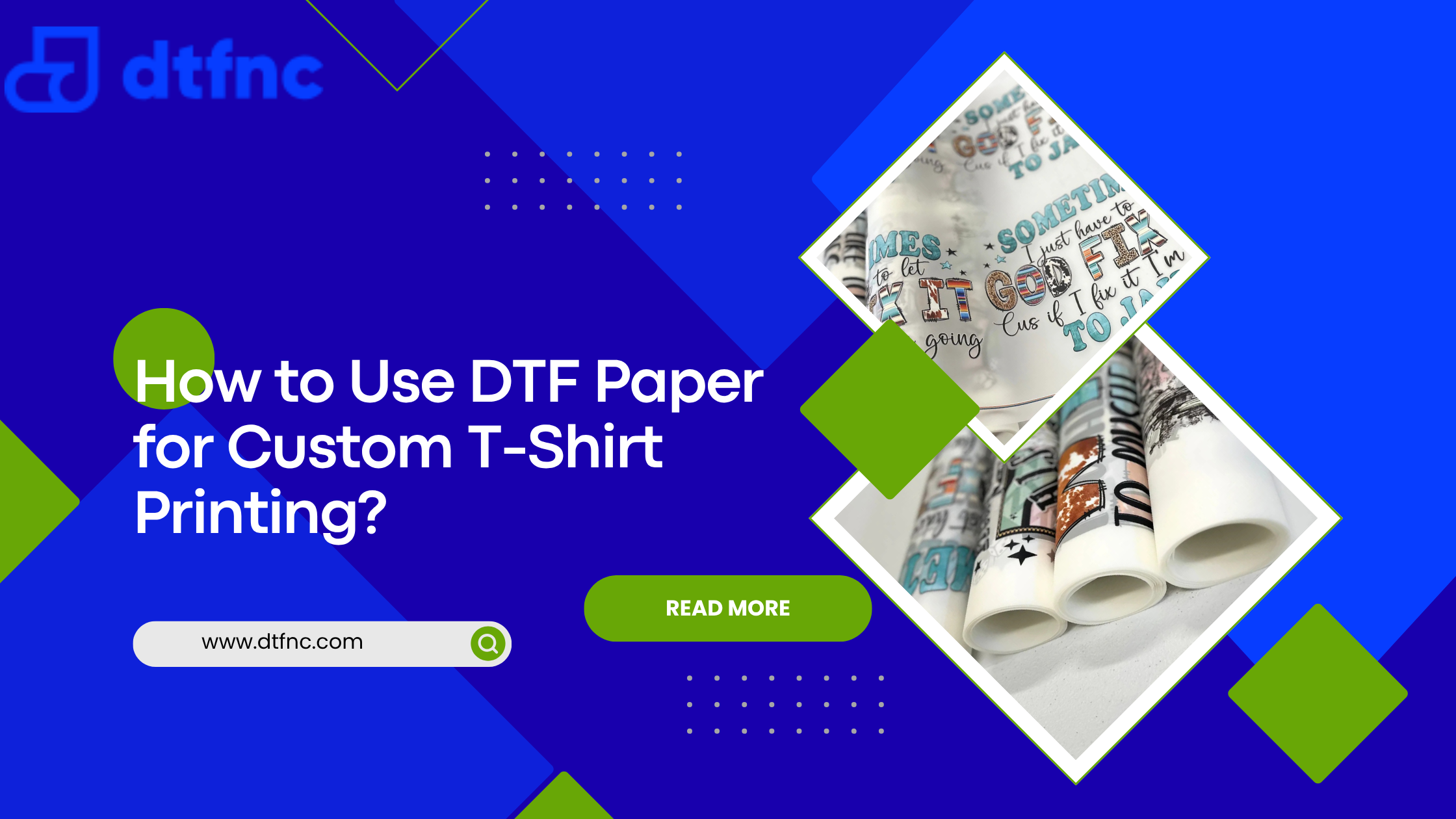Direct to Film (DTF) printing has gained significant popularity in the world of custom apparel and fabric printing due to its versatility and high-quality results. However, like any printing technology, DTF is not without its challenges.
Most Common DTF Printing Problems and Solutions
Direct to Film (DTF) printing has gained significant popularity in the world of custom apparel and fabric printing due to its versatility and high-quality results. However, like any printing technology, DTF is not without its challenges. In this blog post, we will explore the most common DTF printing problems and provide practical solutions to help you overcome these issues and achieve optimal printing results.
DTF Printing Problem #1: Ink Smudging

Problem:
One of the prevalent issues in DTF printing is ink smudging, which can ruin the quality of your prints. This problem often occurs when the ink is not drying properly or when excessive ink is applied.
Solution:
To solve this problem, ensure that you are using the right ink for your printer and fabric type. Additionally, check and adjust the curing settings on your printer to ensure proper drying.
DTF Printing Problem #2: Image Blurring
Problem:
Image blurring can result from various factors, such as printhead misalignment, low resolution images, or incorrect printing speed.
Solution:
To address this problem, calibrate your printhead regularly, use high-resolution images, and adjust the printing speed to match the specifications of your printer.
DTF Printing Problem #3: Color Inconsistencies

Problem:
Inconsistent colors can be frustrating, especially when working on projects that demand precise color matching.
Solution:
To resolve this issue, calibrate your printer regularly, use color management tools, and ensure that your software settings are configured correctly. Additionally, check for any clogs in the ink lines that might be affecting color distribution.
DTF Printing Problem #4: Film Wrinkling
Problem:
Film wrinkling during the printing process can lead to misalignment and poor print quality.
Solution:
To prevent this issue, make sure that your film is properly loaded and that the tension is adjusted correctly. Avoid overstretching the film, as this can cause wrinkles during printing.
DTF Printing Problem #5: Poor Adhesion

Problem:
Poor adhesion of the film to the fabric can result in peeling and reduced durability of the print.
Solution:
Ensure that you are using the right adhesive for your specific fabric type. Additionally, check the curing settings on your printer to optimize adhesion during the printing process.
DTF Printing Problem #6: White Ink Issues
Problem:
White ink plays a crucial role in DTF printing, especially on dark fabrics. Issues such as uneven coverage and clogging of white ink channels can occur.
Solution:
To address these problems, regularly agitate and circulate white ink in the system. Ensure that the white ink channels are clean and free from any obstructions.
DTF Printing Problem #7: Clogging of Printer Heads
Problem:
Printer head clogs can disrupt the printing process and result in inconsistent prints.
Solution:
Regular maintenance, including cleaning the printheads and using appropriate cleaning solutions, can prevent clogging. Additionally, avoid using expired or low-quality inks that may contribute to printhead issues.
DTF Printing Problem #8: Printhead Strikes

Problem:
Printhead strikes can cause damage to both the printhead and the substrate.
Solution:
Check for any obstructions on the printing bed, ensure proper media placement, and adjust the printhead height to avoid strikes. Regularly clean the printhead to prevent the buildup of debris that can lead to strikes.
DTF Printing Problem #9: Film Not Transferring Properly
Problem:
If the film is not transferring correctly to the fabric, it can result in incomplete prints.
Solution:
Check the temperature and pressure settings on your heat press, ensuring that they align with the recommended specifications for your DTF film and fabric. Experiment with different settings to find the optimal conditions for proper film transfer.
Also Read: How to Press DTF Transfers on T-shirts
DTF Printing Problem #10: Image Distortion
Problem:
Image distortion can occur due to issues with the film, such as stretching or misalignment.
Solution:
Ensure that the film is loaded correctly and that the tension is balanced. Additionally, check for any abnormalities in the printing process, such as sudden speed changes or printhead malfunctions, which can contribute to image distortion.

DTF Printing Problem #11: Film Peeling Off
Problem:
Film peeling off after printing can be a result of poor adhesion or incorrect curing settings.
Solution:
Double-check the curing temperature and time to ensure proper bonding between the film and fabric. Experiment with different curing conditions to find the optimal settings for preventing film peeling.
Conclusion
While DTF printing offers a powerful solution for custom apparel and fabric printing, addressing common printing problems is essential to achieve consistent and high-quality results.
Regular maintenance, proper calibration, and adherence to recommended settings are crucial steps in overcoming these challenges. By understanding and implementing solutions to these common problems, you can enhance your DTF printing experience and ensure successful and vibrant prints.
FAQs
Q: What are the problems with DTF printer?
A: Common problems with DTF printers include ink smudging, image blurring, color inconsistencies, film wrinkling, poor adhesion, white ink issues, printhead clogs, printhead strikes, film not transferring properly, image distortion, and film peeling off.
Q: Why is my DTF ink not coming out?
A: DTF ink may not be coming out due to clogged printheads, improper ink settings, or using expired or low-quality ink. Regular maintenance, proper ink circulation, and using high-quality ink can help resolve this issue.
Q: What causes spots on DTF transfers?
A: Spots on DTF transfers can be caused by printhead issues, such as clogs or misalignment. Regular printhead maintenance and ensuring proper printing conditions can help eliminate spots on DTF transfers.
Q: What are the disadvantages of DTF printing?
A: Disadvantages of DTF printing include the need for specialized equipment, occasional maintenance requirements, and potential challenges in achieving color accuracy on certain fabrics. However, with proper care and troubleshooting, these disadvantages can be mitigated.
Q: Why are my DTF transfers not sticking to my shirt?
A: DTF transfers may not stick to the shirt due to poor adhesion, incorrect curing settings, or using the wrong adhesive for the fabric type. Adjusting the curing conditions and ensuring proper adhesive selection can help improve adhesion and bonding.










8102 comments
AllenHap
milf porno
Juniorintak
https://judahrvewe.blogocial.com/una-llave-simple-para-capacitacion-de-liderazgo-online-unveiled-73044935
Apostar en una formacion de liderazgo digital ya no es un lujo, sino una prioridad para cualquier negocio que busca adaptarse en el contexto moderno.
Un buen curso de liderazgo empresarial no solo ensena conocimiento, sino que activa la practica del liderazgo de mandos medios que estan en terreno.
Por que elegir una formacion en liderazgo online?
Autonomia para aprender sin interrumpir el dia a dia.
Acceso a contenidos actualizados, incluso si estas fuera de zonas urbanas.
Precio mas accesible que una opcion fisica.
En el mercado laboral chileno, un curso de liderazgo chile debe responder a la cultura chilena:
Jerarquias marcadas.
Millennials vs. jefaturas tradicionales.
Desafios post pandemia.
Por eso, una capacitacion en liderazgo debe ser mas que un taller generico.
Que debe incluir un buen curso de liderazgo para jefaturas?
Unidades sobre comunicacion efectiva.
Simulaciones adaptados a contextos reales.
Evaluacion individual de competencias.
Networking con otros gerentes de regiones.
Y lo mas importante: el programa formativo debe impulsar un impacto concreto en la eficacia del liderazgo.
Cientos de jefes llegan al puesto sin guia, y eso impacta a sus areas. Un buen programa para lideres puede ser la clave entre liderar con claridad o improvisar.
Juniorintak
https://pr12345.blogdigy.com/todo-acerca-de-servicios-de-levantamiento-y-dise%C3%B1o-de-perfiles-de-cargo-44795344
La correcta generación de perfiles de cargo es hoy un tema clave para organizaciones que buscan crecer. Sin un diseño perfiles de cargo, los procesos de contratación se vuelven ineficientes y el ajuste con los candidatos falla.
En Chile, donde los sectores mutan rápido, el levantamiento perfiles de cargo ya no es un lujo. Es la única forma de entender qué competencias son necesarias en cada rol.
Imagina: sin una renovación de perfiles de cargo, tu empresa pierde dinero contratando sin norte. Los perfiles de cargo que fueron obsoletos desorientan tanto a líderes como a trabajadores.
Errores típicos al trabajar perfiles de cargo
Armar documentos demasiado genéricas.
Copiar modelos gringos que no calzan en la realidad chilena.
Pasar por alto la revisión de perfiles de cargo después de cambios.
No involucrar a los colaboradores en el proceso de perfiles de cargo.
Recomendaciones para un modelo de perfiles de cargo real
Arrancar con el mapa de perfiles de cargo: entrevistas, focus groups y sondeos a jefaturas.
Alinear habilidades clave y aptitudes duras.
Diseñar un documento claro que detalle tareas y rangos de desempeño.
Establecer la puesta al día de perfiles de cargo al menos cada 12 meses.
Cuando los documentos de cargo están actualizados, tu organización logra tres ventajas claves:
Selecciones más efectivos.
Colaboradores más comprometidos.
Planes de desarrollo más justos.
AllenHap
milf porno
Juniorintak
https://online67642.shotblogs.com/una-llave-simple-para-capacitacion-de-liderazgo-online-unveiled-51286525
Invertir en una capacitacion de liderazgo online ya no es un beneficio opcional, sino una necesidad para cualquier negocio que busca competir en el mercado actual.
Un buen taller de liderazgo ejecutivo no solo ensena contenido, sino que transforma la manera de dirigir de mandos medios que ya estan activos.
Por que elegir una escuela de liderazgo remota?
Libertad para progresar sin frenar el ritmo laboral.
Entrada a modulos actualizados, incluso si vives fuera de zonas urbanas.
Costo mas razonable que una opcion fisica.
En el escenario local, un entrenamiento para lideres chilenos debe responder a realidades locales:
Cadenas de mando tradicionales.
Equipos multigeneracionales.
Desconexion entre areas.
Por eso, una capacitacion en liderazgo debe ser mas que un curso grabado.
Que debe incluir un buen curso de liderazgo empresarial?
Clases sobre comunicacion efectiva.
Simulaciones adaptados a contextos reales.
Retroalimentacion individual de estilo de liderazgo.
Networking con otros lideres de diferentes industrias.
Y lo mas importante: el entrenamiento de jefaturas debe provocar un salto significativo en la eficacia del liderazgo.
Cientos de encargados llegan al puesto sin formacion, y eso frena a sus colaboradores. Un buen curso de liderazgo para jefaturas puede ser la solucion entre inspirar y dirigir o sobrevivir.